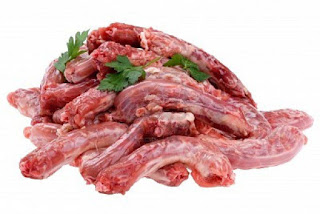Raw Chicken Necks Food: Clean the teeth and Increase breath for Dogs
If you came across this text, there square measure possibilities that your dog is obtaining older and you're inquisitive what bones would work best to assist keep those dental issues trapped. Or, even higher, you will own a young dog and need to stop dental issues from occurring within the 1st place. If so, approval to you, as preventing is far higher than solidifying one thing that would are avoided a minimum of to an explicit extent. Let's 1st take a glance at what plaque is and the way it affects our canine companions.
It's shaped by bacterium naturally found within the dog's spittle that adheres to the surface of the dog's teeth. Initially, the film is soft and might simply return off by merely scraping the dog's tooth with a nail or the bristles of a toothbrush. With time tho' (if left on the teeth), the plaque can harden within the next 2 to 3 days and shortly can calcify, changing into yellowish/brown tartar that becomes more durable to get rid of. On prime of that, once tartar is a gift, the tooth surface becomes rougher, inflicting a lot of plaque and tartar to create up. Once enough tartar collects within the dog’s mouth, it probably lands up underneath the gums inflicting issues. At now, the hardened tartar will not be simply removed with the toothbrush and can probably need inaudible tools or a hand-held pulse counter to get rid of effectively, one thing that has to be done by a vet underneath anaesthesia.
Now, I do know what you’re assuming: “Aren’t bones dangerous?” a lot of folks think that (heck, I accustomed to assuming that tool), however, the reality is Dog Food Raw Chicken Necks aren’t dangerous, particularly once you follow many simple tips (which I’ll share with you in an exceedingly bit). Before we tend to get thereto, though, let’s take a more in-depth check out bones and why they’re one among the most effective ways in which to stay your pet’s teeth and gums healthy.
Do Raw Bones extremely Clean Dogs Teeth?
Yes! Within the wild, canines clean their teeth by mastication the bones of their prey. However before you extra services on bones from the butcher, there square measure many things to contemplate. There’s much concern out there regarding bones and a few of its even. You will have detected that bones will splinter and cause internal injuries to our pets. Or, those dogs will crack their teeth on them, or perhaps swallow massive bits which will cause internal organ obstructions. These items square measure attainable, however conjointly preventable if you follow some easy pointers.
(a) Feed Raw Bones solely
Cooked bones will splinter and cause injuries, either in your dog’s mouth or in their system alimentation. Smoke-cured bones and antlers are often too onerous, inflicting cracks in your dog’s teeth. Solely feed your dog 100% raw bones.
(b) Don’t Feed Dense Bones
Weight-bearing bones of enormous animals, like cows and bovid, square measure extraordinarily dense. keep one's hands off from leg bones of enormous animals, as they will increase the chance of cracking teeth.
(c) Feed the correct Size of Bone
Feeding bones that square measure large and dense will cause cracked teeth likewise and bones that square measure too tiny will raise the chance of swallowing massive items. Ideally, bones ought to be larger than your dog’s mouth, so that they can’t set out huge chunks. For terribly tiny dogs, the rule of thumb is that if you can’t cut the bone with room scissors, it’s in all probability too huge or too onerous. Ideally, your dog ought to pay regarding half-hour, two or three times every week, acting on bones for an obvious improvement in dental health.
Source link:



Comments
Post a Comment